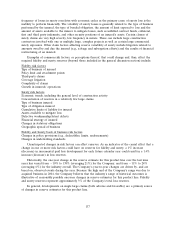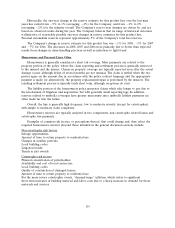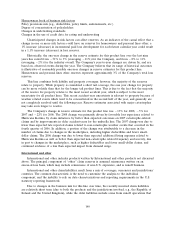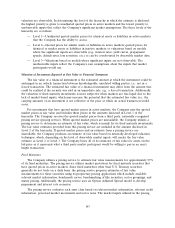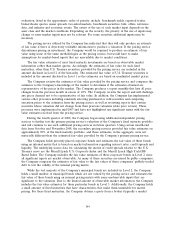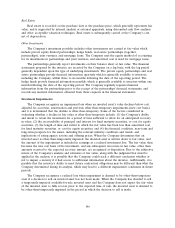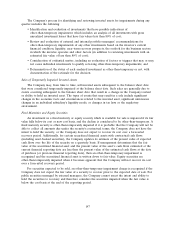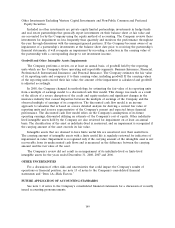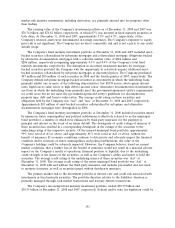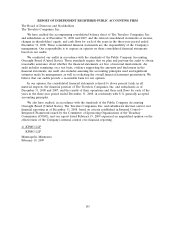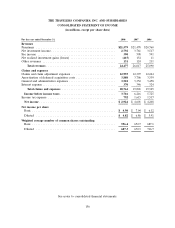Travelers 2008 Annual Report Download - page 158
Download and view the complete annual report
Please find page 158 of the 2008 Travelers annual report below. You can navigate through the pages in the report by either clicking on the pages listed below, or by using the keyword search tool below to find specific information within the annual report.Real Estate
Real estate is recorded on the purchase date at the purchase price, which generally represents fair
value, and is supported by internal analysis or external appraisals, using discounted cash flow analyses
and other acceptable valuation techniques. Real estate is subsequently carried at the Company’s cost,
net of depreciation.
Other Investments
The Company’s investment portfolio includes other investments not carried at fair value which
include private equity limited partnerships, hedge funds, real estate partnerships (together,
partnerships), joint ventures, and mortgage loans. The Company uses the equity method of accounting
for its investments in partnerships and joint ventures, and amortized cost is used for mortgage loans.
The partnerships generally report investments on their balance sheet at fair value. The financial
statements prepared by the investee are received by the Company on a lag basis, with the lag period
generally dependent upon the type of underlying investments. The private equity partnerships and real
estate partnerships provide financial information quarterly which is generally available to investors,
including the Company, within three to six months following the date of the reporting period. The
hedge funds provide financial information monthly, which is generally available to investors within one
month following the date of the reporting period. The Company regularly requests financial
information from the partnerships prior to the receipt of the partnerships’ financial statements, and
records any material information obtained from these requests in the financial statements.
Investment Impairments
The Company recognizes an impairment loss when an invested asset’s value declines below cost,
adjusted for accretion, amortization and previous other-than-temporary impairments (new cost basis),
and it is determined that the decline is other-than-temporary. Some of the factors considered in
evaluating whether a decline in fair value is other-than-temporary include: (1) the Company’s ability
and intent to retain the investment for a period of time sufficient to allow for an anticipated recovery
in value; (2) the recoverability of principal and interest for fixed maturity securities, or cost for equity
securities; (3) the length of time and extent to which the fair value has been less than amortized cost
for fixed maturity securities, or cost for equity securities; and (4) the financial condition, near-term and
long-term prospects for the issuer, including the relevant industry conditions and trends, and
implications of rating agency actions and offering prices. When the Company determines that an
invested asset is other-than-temporarily impaired, the invested asset is written down to fair value, and
the amount of the impairment is included in earnings as a realized investment loss. The fair value then
becomes the new cost basis of the investment, and any subsequent recoveries in fair value, other than
amounts accreted to the expected recovery amount, are recognized at disposition. Due to the subjective
nature of the Company’s analysis and estimates of fair value, along with the judgment that must be
applied in the analysis, it is possible that the Company could reach a different conclusion whether or
not to impair a security if it had access to additional information about the investee. Additionally, it is
possible that the investee’s ability to meet future contractual obligations may be different than what the
Company determined during its analysis, which may lead to a different impairment conclusion in future
periods.
The Company recognizes a realized loss when impairment is deemed to be other-than-temporary
even if a decision to sell an invested asset has not been made. When the Company has decided to sell
a temporarily impaired available-for-sale invested asset and the Company does not expect the fair value
of the invested asset to fully recover prior to the expected time of sale, the invested asset is deemed to
be other-than-temporarily impaired in the period in which the decision to sell is made.
146



